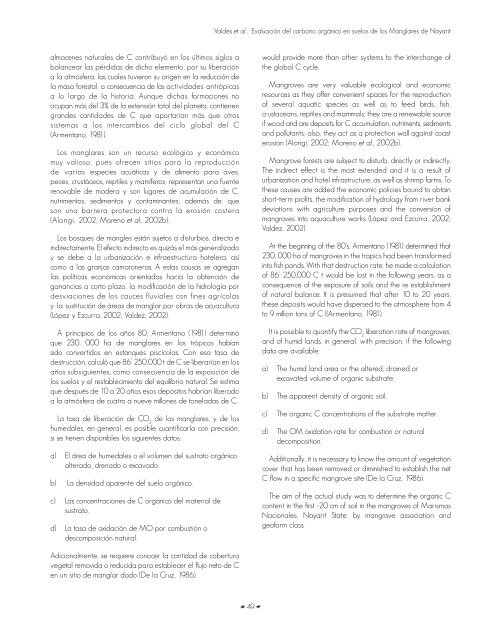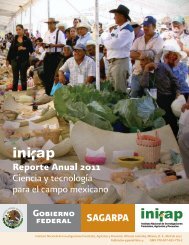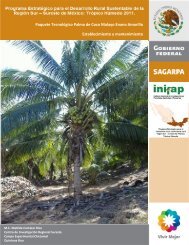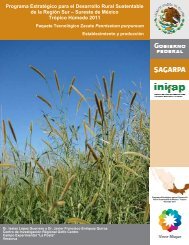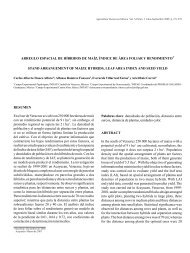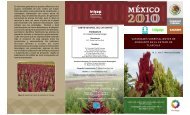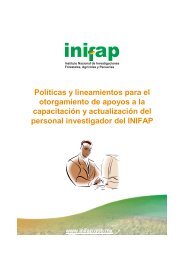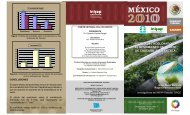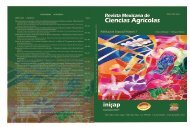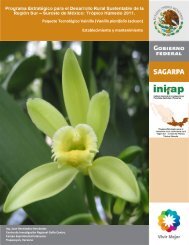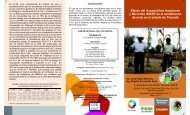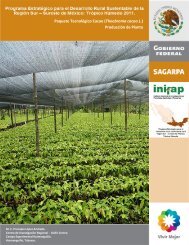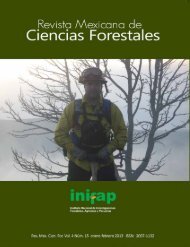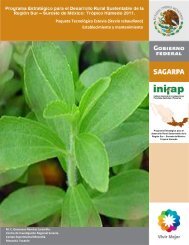Vol. 2 Núm. 8 - Instituto Nacional de Investigaciones Forestales ...
Vol. 2 Núm. 8 - Instituto Nacional de Investigaciones Forestales ...
Vol. 2 Núm. 8 - Instituto Nacional de Investigaciones Forestales ...
- No tags were found...
You also want an ePaper? Increase the reach of your titles
YUMPU automatically turns print PDFs into web optimized ePapers that Google loves.
Valdés et al., Evaluación <strong>de</strong>l carbono orgánico en suelos <strong>de</strong> los Manglares <strong>de</strong> Nayaritalmacenes naturales <strong>de</strong> C contribuyó en los últimos siglos abalancear las pérdidas <strong>de</strong> dicho elemento, por su liberacióna la atmósfera, las cuales tuvieron su origen en la reducción <strong>de</strong>la masa forestal, a consecuencia <strong>de</strong> las activida<strong>de</strong>s antrópicasa lo largo <strong>de</strong> la historia. Aunque dichas formaciones noocupan más <strong>de</strong>l 3% <strong>de</strong> la extensión total <strong>de</strong>l planeta, contienengran<strong>de</strong>s cantida<strong>de</strong>s <strong>de</strong> C que aportarían más que otrossistemas a los intercambios <strong>de</strong>l ciclo global <strong>de</strong>l C(Armentano, 1981).Los manglares son un recurso ecológico y económicomuy valioso, pues ofrecen sitios para la reproducción<strong>de</strong> varias especies acuáticas y <strong>de</strong> alimento para aves,peces, crustáceos, reptiles y mamíferos; representan una fuenterenovable <strong>de</strong> ma<strong>de</strong>ra y son lugares <strong>de</strong> acumulación <strong>de</strong> C,nutrimentos, sedimentos y contaminantes; a<strong>de</strong>más <strong>de</strong>, queson una barrera protectora contra la erosión costera(Alongi, 2002; Moreno et al., 2002b).Los bosques <strong>de</strong> mangles están sujetos a disturbios, directa eindirectamente. El efecto indirecto es quizás el más generalizadoy se <strong>de</strong>be a la urbanización e infraestructura hotelera, asícomo a las granjas camaroneras. A estas causas se agreganlas políticas económicas orientadas hacia la obtención <strong>de</strong>ganancias a corto plazo, la modificación <strong>de</strong> la hidrología por<strong>de</strong>sviaciones <strong>de</strong> los cauces fluviales con fines agrícolasy la sustitución <strong>de</strong> áreas <strong>de</strong> manglar por obras <strong>de</strong> acuacultura(López y Ezcurra, 2002; Val<strong>de</strong>z, 2002).A principios <strong>de</strong> los años 80, Armentano (1981) <strong>de</strong>terminóque 230, 000 ha <strong>de</strong> manglares en los trópicos habíansido convertidos en estanques piscícolas. Con esa tasa <strong>de</strong><strong>de</strong>strucción, calculó que 86’ 250,000 t <strong>de</strong> C se liberarían en losaños subsiguientes, como consecuencia <strong>de</strong> la exposición <strong>de</strong>los suelos y el restablecimiento <strong>de</strong>l equilibrio natural. Se estimaque <strong>de</strong>spués <strong>de</strong> 10 a 20 años esos <strong>de</strong>pósitos habrían liberadoa la atmósfera <strong>de</strong> cuatro a nueve millones <strong>de</strong> toneladas <strong>de</strong> C.La tasa <strong>de</strong> liberación <strong>de</strong> CO 2<strong>de</strong> los manglares, y <strong>de</strong> loshumedales, en general, es posible cuantificarla con precisión,si se tienen disponibles los siguientes datos:a) El área <strong>de</strong> humedales o el volumen <strong>de</strong>l sustrato orgánicoalterado, drenado o excavado.b) La <strong>de</strong>nsidad aparente <strong>de</strong>l suelo orgánico.c) Las concentraciones <strong>de</strong> C orgánico <strong>de</strong>l material <strong>de</strong>sustrato.d) La tasa <strong>de</strong> oxidación <strong>de</strong> MO por combustión o<strong>de</strong>scomposición natural.would provi<strong>de</strong> more than other systems to the interchange ofthe global C cycle.Mangroves are very valuable ecological and economicresources as they offer convenient spaces for the reproductionof several aquatic species as well as to feed birds, fish,crustaceans, reptiles and mammals; they are a renewable sourceif wood and are <strong>de</strong>posits for C accumulation, nutriments, sedimentsand pollutants; also, they act as a protection wall against coasterosion (Alongi, 2002; Moreno et al., 2002b).Mangrove forests are subject to disturb, directly or indirectly.The indirect effect is the most exten<strong>de</strong>d and it is a result ofurbanization and hotel infrastructure, as well as shrimp farms. Tothese causes are ad<strong>de</strong>d the economic policies bound to obtainshort-term profits, the modification of hydrology from river bank<strong>de</strong>viations with agriculture purposes and the conversion ofmangroves into aquaculture works (López and Ezcurra, 2002;Val<strong>de</strong>z, 2002).At the beginning of the 80’s, Armentano (1981) <strong>de</strong>termined that230, 000 ha of mangroves in the tropics had been transformedinto fish ponds. With that <strong>de</strong>struction rate, he ma<strong>de</strong> a calculationof 86’ 250,000 C t would be lost in the following years, as aconsequence of the exposure of soils and the re establishmentof natural balance. It is presumed that after 10 to 20 years,these <strong>de</strong>posits would have dispersed to the atmosphere from 4to 9 million tons of C ((Armentano, 1981).It is possible to quantify the CO 2liberation rate of mangroves,and of humid lands, in general, with precision, if the followingdata are available:a) The humid land area or the altered, drained orexcavated volume of organic substrate.b) The apparent <strong>de</strong>nsity of organic soil.c) The organic C concentrations of the substrate matter.d) The OM oxidation rate for combustion or natural<strong>de</strong>composition.Additionally, it is necessary to know the amount of vegetationcover that has been removed or diminished to establish the netC flow in a specific mangrove site (De la Cruz, 1986).The aim of the actual study was to <strong>de</strong>termine the organic Ccontent in the first -20 cm of soil in the mangroves of Marismas<strong>Nacional</strong>es, Nayarit State, by mangrove association andgeoform class.Adicionalmente, se requiere conocer la cantidad <strong>de</strong> coberturavegetal removida o reducida para establecer el flujo neto <strong>de</strong> Cen un sitio <strong>de</strong> manglar dado (De la Cruz, 1986).49


